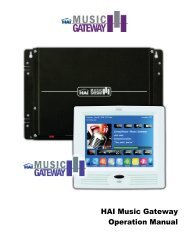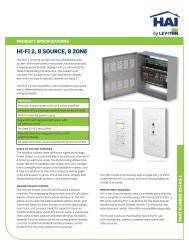Download PDF - Home Automation, Inc
Download PDF - Home Automation, Inc
Download PDF - Home Automation, Inc
You also want an ePaper? Increase the reach of your titles
YUMPU automatically turns print PDFs into web optimized ePapers that Google loves.
WIRING DIAGRAMS<br />
WIRING DIAGRAM<br />
2 0 1 2 P R O D U C T C A T A L O G<br />
Omni-Bus Lighting Control Network<br />
102 www.homeauto.com<br />
1. Network Cable<br />
a. CAT5 UTP (Category 5 Unshielded Twisted<br />
pair (4 pairs), stranded or single core)<br />
2. Crimp Connectors<br />
a. All cable ends must be terminated with RJ45<br />
plugs.<br />
3. Network Termination Plug<br />
a. Each network must have ONE and only one<br />
network Termination Plug (122A00-1).<br />
b. It is recommended that the Termination<br />
Plug always be installed at the power supply<br />
interface.<br />
4. Jumpers<br />
a. No open ends or open connectors are allowed<br />
on the network.<br />
b. All open ends or open connectors must<br />
be terminated with a Network Jumper Plug<br />
(121A00-1).<br />
5. Splitters<br />
a. Where a T-junction or network split is<br />
required, a Splitter box must be used (119A00-<br />
1 or 120A00-1).<br />
b. A Splitter can be inserted anywhere on the<br />
network.<br />
6. Power Supply<br />
a. Each Power Supply Unit must be connected<br />
to the network via a separate Power Supply<br />
Interface unit (124A00-1).<br />
b. Each power supply can supply up to 2A to the<br />
network.<br />
c. More than one power supply can be used if the<br />
total network current consumption exceeds 2A<br />
d. To obtain the total current requirement, add<br />
up the individual current consumptions of all<br />
devices on the network.<br />
e. The power supply(s) must be installed at the<br />
point where most devices are located (usually the distribution board) to avoid excessive voltage drops over long cables<br />
f. The supply voltage at any point on the cable (pin 1 and 8) must be between 15 and 24VDC.<br />
7. Supply Distribution<br />
a. The total number of devices on a single network split from the power supplies must not exceed 50 devices.<br />
b. The total current consumption of devices on a single network split from the power supplies must not exceed 2A.<br />
8. Device Placement and Isolation<br />
a. The HAI Omni-Bus units have been designed to operate over an ambient temperature range between 0 ºC and 40 ºC at the rated maximum load capacities.<br />
Sufficient spacing and airflow between devices should be allowed for in the distribution board. The minimum recommended horizontal spacing between dimmer<br />
devices<br />
is one din rail module width (17mm or 2/3inches).<br />
b. All network connections and cabling are low voltage and optically isolated from the mains supply voltage and must thus be kept away from any mains wiring.<br />
c. Sufficient spacing must be allowed for this between consecutive din rails in the distribution board (minimum recommended spacing between din rail centers =<br />
150mm or 6inches).<br />
d. Do NOT route any network cables via the same conduits as mains wiring.<br />
9. Maximum Cable Length<br />
a. The total cable length on a single bus network may not exceed 1000m (3280feet).<br />
10. Maximum Number of Devices<br />
a. The total number of devices on a single bus network may not exceed 256.












